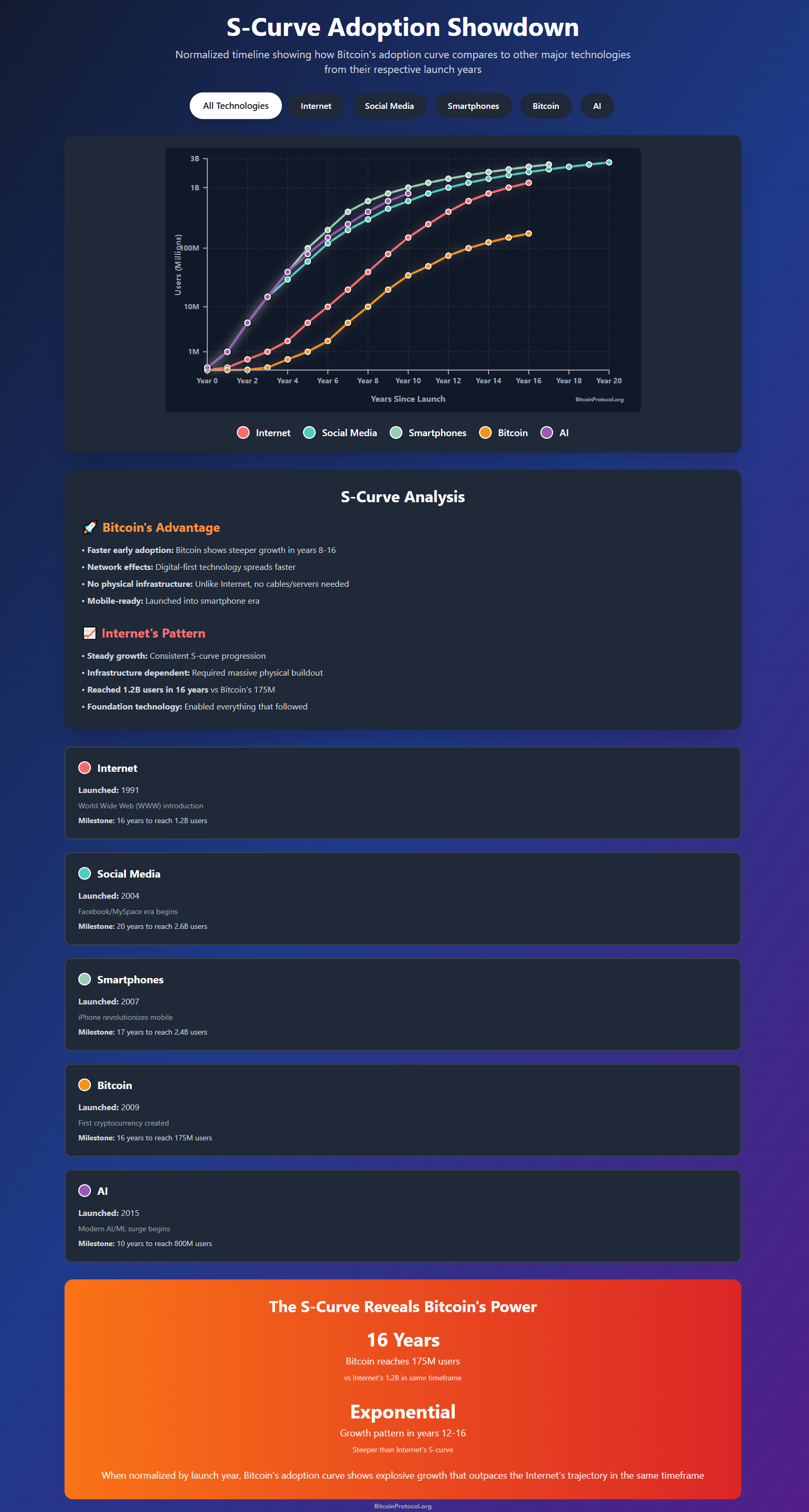Bitcoin Adoption Gains Speed Compared to Internet Growth and Major Technologies

The ascent of Bitcoin as a global financial innovation has sparked comparisons to the Internet’s rapid expansion in the 1990s, with data indicating that Bitcoin’s adoption is accelerating faster during certain stages. Unlike the Internet, which required extensive physical infrastructure, Bitcoin has capitalized on existing digital networks to grow quickly, especially in recent years. Milestones like the 2024 launch of Bitcoin ETFs and in 2025 pro-crypto regulations have driven this surge.
This article examines Bitcoin’s adoption curve relative to the Internet’s, highlighting key growth phases and the broader landscape of technological adoption.
The Internet, catalyzed by the World Wide Web in 1991, took about eight years to reach 3% global adoption by mid-1999, growing from 16 million users in 1995 to 248 million by 1999. This represented a rise from 0.28% to 4.13% of a global population of roughly 6 billion, with the jump from 1% adoption in early 1997 to 3% taking approximately 2.6 years. Affordable hardware and new online services fueled this growth, though building networks like broadband initially slowed progress. The Internet’s steady expansion laid the groundwork for modern digital technologies.
Bitcoin, launched in 2009, has reached an estimated 175 million users by mid-2025, equating to 2.15% of a global population of 8.2 billion, a milestone achieved over 16 years. While Bitcoin’s overall timeline to approach this level is longer than the Internet’s, its growth from 1% adoption in mid-2023 (around 125 million users) to 2.15% by mid-2025 has been notably swift, taking just two years. Our projections suggest Bitcoin could near 3% adoption (around 250 million users) by early 2026, outpacing the Internet’s 2.6-year span for a similar leap. This rapid growth leverages existing internet infrastructure, sidestepping the physical barriers the Internet faced.
Stay In The Loop and Never Miss Important Bitcoin News
Sign up and be the first to know when we publishFurther Analyzing Adoption Trajectories
Several factors have propelled Bitcoin’s recent surge. The 2021 bull market, with Bitcoin’s price hitting $69,000, attracted millions of new users, while the 2024 approval of U.S. spot Bitcoin ETFs brought institutional capital into the market. By December 2024, Bitcoin’s price reaching $100,000, alongside policies like the U.S. strategic Bitcoin reserve in March 2025, further boosted adoption. These developments have made Bitcoin more accessible and credible, drawing both retail and institutional interest.
The Internet’s growth, by contrast, relied on technological advancements like faster modems and widespread PC access. Bitcoin benefits from smartphones and digital crypto exchanges, enabling near-instant global reach. By mid-2023, Bitcoin’s 1% adoption reflected around 125 million users, a figure that grew by roughly 50 million in two years. This pace highlights how modern technologies can scale rapidly once they gain traction, a trend also seen in smartphones, social media, cloud computing, and artificial intelligence.
These technologies offer valuable comparisons. Smartphones achieved 84% penetration in North America by 2023, driven by user-friendly designs and app ecosystems. Social media’s growth, propelled by network effects, parallels Bitcoin’s community-driven rise, while cloud computing and AI have scaled through accessibility and corporate adoption. Regional disparities, like lower smartphone use in Sub-Saharan Africa, affect Bitcoin’s global spread, but its digital nature mitigates some barriers.
Bitcoin’s adoption faces hurdles, including regulatory challenges and price volatility, yet its decentralized appeal and growing acceptance as a store of value and medium of exchange sustain its momentum. The Internet’s growth was less contentious, focused on enhancing communication, while Bitcoin’s financial disruption invites greater debate. As Bitcoin approaches 3% adoption, its trajectory suggests it could achieve widespread use faster than the Internet, driven by digital infrastructure and institutional support. For now, Bitcoin’s rapid rise offers a compelling lens into how transformative technologies reshape the world.
Below is a chart we made showing Bitcoin's S-Curve adoption rate, with a normalized timeline showing how Bitcoin's adoption curve compares to other major technologies like Internet, Social Media, Smart Phones, and AI, from their respective launch years.


